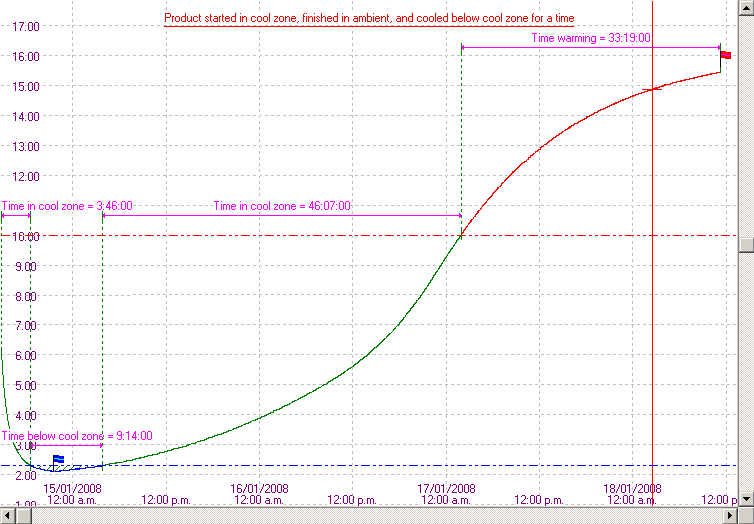View Menu > Statistics View > Product Integrity Profile (PIP)
A frequent use of Temprecord data loggers is to monitor the temperature of a shipment with passive refrigeration, i.e where cooling of the product is achieved by adding refrigerated ballast such as ice packs to the consignment. The temperature profile thus starts off at a relatively higher temperature, falls to a minimum, then warms back to ambient. The goal is to ensure the product cools quickly and remains in the safe storage temperature zone for the anticipated duration of the journey. Blood products tend to use this type of refrigeration where the container is made from expanded polystyrene foam.
If a Temprecord logger is included with the shipment, the Temprecord program provides the ability to quickly analyse a temperature record and determine key indicators via the Product Integrity Profile. The information is presented in the form of annotations on the graph, and a report as part of the statistics. Both of these functions can be enabled with the Show Product Integrity Statistics option.
Definitions
PIP |
Product Integrity Profile |
Cool zone |
the desired temperature range in which the product should remain |
Above cool zone or ambient |
temperatures above the cool zone, i.e. where the product is too warm |
Below cool zone |
temperatures below the cool zone - i.e. where the product is too cold |
Time to cool |
the time taken for the temperature to cool from the start until the upper limit of the cool zone |
Time in cool zone |
the time the product spent inside the cool zone. If the product cooled below the lower limit, the time in the cool zone will be shown as two sections: the time taken to cool from the upper temperature limit down to the lower temperature limit (when the temperature enters the blow cool zone), and the time taken to warm from the lower temperature limit up to the upper temperature limit (when the temperature enters the above cool zone or ambient). The time when reported in the statistics report is the sum of these values. |
Time below cool zone |
the time spend below the lower temperature of the cool zone |
Time warming |
the time taken for the temperature to reach the end after exiting the cool zone |
|
The Product Integrity Profile statistics are intended for situations where the temperature does not enter and leave the cool zone repeatedly. In an environment where the temperature was cycling due to the action of a thermostat, and the temperature was repeatedly crossing the upper or lower limit, the PIP statistics are less likely to be relevant and should be used with care. |
The start sample sets the start position of the PIP analysis. The end sample sets the end position. For a logger or file that has just been read the start and end samples are set to the first and last samples. This may be appropriate or you can change them at any time, and the PIP statistics will be recalculated and displayed for the data between the new start and end samples.
The upper temperature limit sets the upper boundary of the cool zone and the lower temperature limit the lower boundary. For a logger or file that has just been read these limits are set to the limits the logger was programmed with. You can change the limits at any time, and the PIP statistics will be recalculated and displayed for the new upper and lower limits.
In the example below, the upper and lower limits are set to 10C and 2.3C, and the start and end samples are set to the first and last samples.
|
|
To avoid small temperature variations near the limits causing confusing results, the average of the last three temperature samples is used when determining if the temperature has progressed from one zone to the next. For this reason, there can be a delay of several samples before the temperature progresses to another zone.
You should bear this in mind when comparing the temperature limits with the reported times. |
